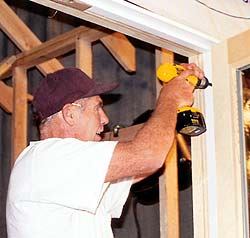Overall Results Attempting to rank tools after performing a variety of tests can be tricky. We’ve dealt with it by grading on a curve. We calculated the performance of each drill as a percentage of the best tool in both the screw and spade bit tests. This meant that the best drill in each test received a score of 100%. Next, we took an average of both curved test scores to determine the overall rating of each drill (see ).
Panasonic EY6230 15.6 V
Panasonic Industrial Tool One Panasonic Way, 4A-3
Secaucus, NJ 07094
201/392-6655
Speed Range (low/high):
65-450/200-1,450
Max Torque (low speed/
high speed): 273/73
Weight: 5 lb., 2 oz.
Street Price: $200
Ryobi CTH1442K2 Ryobi America Corp.
1424 Pearman Dairy Rd.
Anderson, SC 29625
800/525-2579
www.ryobi.com
Speed Range (low/high):
0-350/0-1,300
Max Torque (low speed/
high speed): 300/92
Weight: 4 lb., 9 oz.
Street Price: $139
Bosch 3615 S-B Power Tools 4300 W. Peterson Chicago, IL 60646 877/267-2499 www.boschtools.com Speed Range (low/high): 0-400/0-1,420 Max Torque (low speed/ high speed): 250/80 Weight: 4 lb., 6.5 oz. Street Price: $200 |
Makita 6233D (NiMH) Makita USA 14930 Northam Street La Mirada, CA 90638 800/462-5482 Speed Range (low/high): 0-400/0-1,300 Max Torque (low speed/ high speed): 330/117 Weight: 4 lb., 8.5 oz. Street Price: $280 |
Metabo BEAT214/2 R+L Metabo 1231 Wilson Drive West Chester, PA 19380 800/638-2264 www.metabo.com Speed Range (low/high): 0-400/0-1,400 Max Torque (low speed/ high speed): 209/75 Weight: 5 lb., 11.5 oz. Street Price: $300 |
Ratings. Only the Hitachi, powered with the prototype NiMH 3Ah battery, scored above 90%. This is somewhat misleading, however, because the same Hitachi drill, when powered with its standard issue NiCad battery, scored only 70%. What this means is that the increased Hitachi runtime, when using the prototype 3Ah battery, masked the mediocre performance of the actual drill (minus the battery). To figure out which drill (minus the batteries) performs best, results from the NiCad powered models are the best indicator. Batteries will change during the coming year, but drill design will remain largely the same. The DeWalt was the only NiCad powered drill to approach an overall rating near 90%. Most of the drills, when running on NiCad batteries, came in between 69% and 71%. Slightly behind this group, Ryobi had a rating of 65%. This is noteworthy because the Ryobi, at the low end of professional-quality tools, costs $60 to $140 less than most other professional drills, even though its performance drops off only slightly. At current prices, you can buy two Ryobi drills for the price of one Makita with NiMH batteries. But remember, don’t be tempted to go buy the even cheaper homeowner units, because their performance completely fails to meet the needs of a professional. Which drill you buy depends largely on what kind of work you do and how much you’re willing to spend. DeWalt currently makes the best overall 14.4-volt drill according to our tests. But it is also one of the more expensive. Makita and Panasonic also make good all-around models for both high- and low-torque situations. For high-torque applications specifically, the Makita NiMH and the Panasonic were good performers. Makita has the added advantage of being the only manufacturer to currently offer a NiMH battery option for its drill, which increases runtime. For low-torque applications, the Hitachi and the Milwaukee drills worked well. Keep in mind that as NiMH batteries become available, they will alter these recommendations. If you put a better battery into the same drill, it will run longer. But remember, it will not perform better in other respects. So, if you put the same quality NiMH batteries into the current DeWalt drill as well as the other currently available drills, the DeWalt will still be that much better than the rest. Who comes out with the best batteries, however, remains to be seen. Many manufacturers will be introducing NiMH batteries with 3Ah ratings during 1999. The promising Hitachi prototype that we tested here is slated to be on the market by mid-to-late 1999. How these new batteries perform will need to be evaluated in the future.
